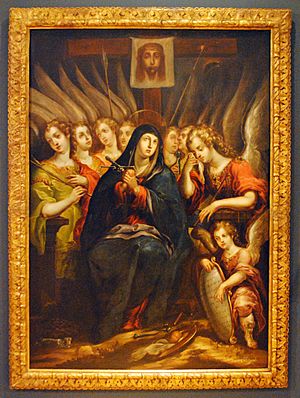Our Lady of Sorrows (Cristóbal de Villalpando) facts for kids
La Dolorosa means Our Lady of Sorrows in Spanish. It is a famous painting by Cristóbal de Villalpando. He probably painted it between 1680 and 1689. Today, you can see this artwork at the Museo Soumaya in Mexico City.
Contents
About the Artist and His Style
Cristóbal de Villalpando was a very important painter. In his early years, he learned from artists like Baltasar de Echave Rioja and Pedro Ramírez. Villalpando's skills grew in the art scenes of Mexico City and Puebla.
He used a style called Baroque. From Echave, he learned to use strong contrasts of light and shadow. This technique is called chiaroscuro. From Ramírez, he learned to make figures look very real and strong. Villalpando also used ideas from Spanish painters like Zurbarán and Rubens.
Villalpando was careful with how he used lines and light. These elements helped tell the story in his paintings. In La Dolorosa, the angels behind the Virgin Mary look like they are moving. But Mary herself looks calm and still. She is placed right in the middle of the painting.
Villalpando often painted a group of angels in a half-circle shape. This "hemicycle of angels" was not just for decoration. It was a common way he showed this theme.
The Story of Our Lady of Sorrows
The idea of honoring the sorrows of the Virgin Mary became popular in the 1500s. This devotion was very strong in New Spain, which is now Mexico. Many writings and paintings showed this theme.
You can see this devotion in places like Acatzingo, Puebla, and Oaxaca. All the religious groups in New Spain supported this belief. Because of this, many paintings of the Mater Dolorosa were created.
This painting by Villalpando used to belong to Dr. José Luis Pérez de Salazar. Later, it became part of the Museo Soumaya collection. The painting was cleaned and fixed in 1995.
Villalpando painted three other versions of the Mater Dolorosa. One is at the Museo Nacional del Virreinato. Another is in the Church of Our Lady of Mount Carmel in Guadalajara. The third is in a private collection.
What the Painting Shows
This painting shows the Virgin Mary as Our Lady of Sorrows. It specifically focuses on her Seven Sorrows. This was a common subject in Christian art. Other similar themes include the Pietà and the Stabat Mater.
The angels behind Mary are dressed in beautiful clothes and jewels. They hold symbols related to the Passion of Christ. These are things from the story of Jesus's suffering and death.
At the top of the painting, there is a cross with an image of Christ. At the bottom, you can see other items from the Passion story. These include nails, a crown of thorns, and dice. Soldiers rolled these dice to decide who would get Christ's clothes.
One angel holds a mirror. This mirror reflects Mary's sadness to the world. If you look closely, you can see words written upside down on the mirror. These words are a part of the Stabat Mater. This is a famous poem about Mary's sorrow by Jacopone da Todi.
The artist's signature, "Villalpando," is at the bottom right of the painting.
See also
 In Spanish: La Dolorosa (Cristóbal de Villalpando) para niños
In Spanish: La Dolorosa (Cristóbal de Villalpando) para niños


